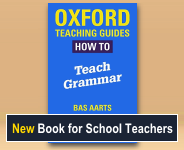Glossary: suffix
Explanation
A suffix is an ‘ending’, used at the end of one word to turn it into another word. Unlike root words, suffixes cannot stand on their own as a complete word.
Contrast prefix.
- call – called
- teach – teacher [turns a verb into a noun]
- terror – terrorise [turns a noun into a verb]
- green – greenish [leaves word class unchanged]
See also affix.
Englicious contains many resources for English language in schools, but the vast majority of them require you to register and log in first. For more information, see What is Englicious?

